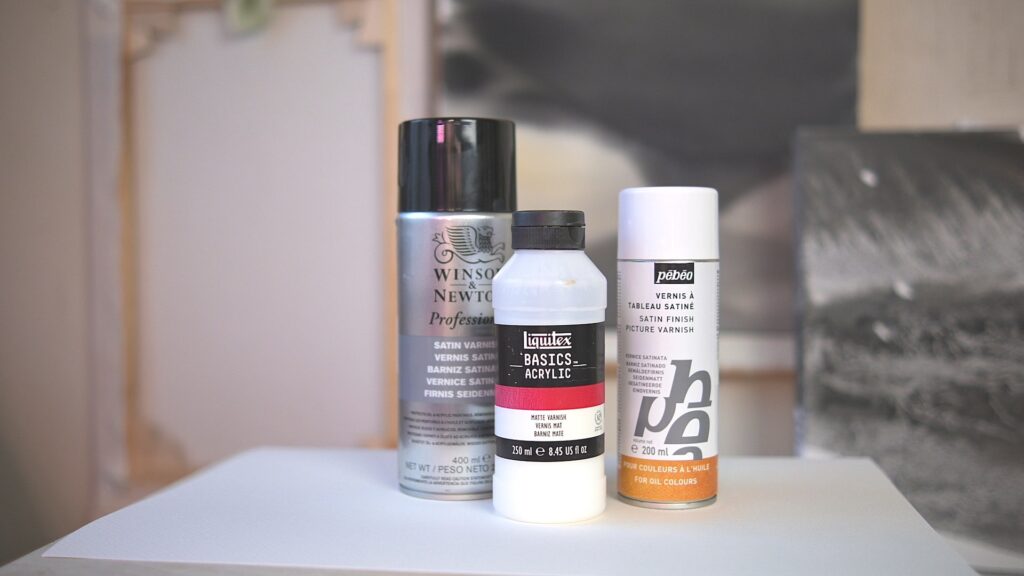Are acrylic paints waterproof?

A question that eventually arises for the artists or DIY enthusiasts: are acrylic paints waterproof?
Varnishing acrylic paintings

Varnishing acrylic paintings Alexandra Lyachina Follow me on Instagram to learn more Varnishing is a final step in the process of creating acrylic paintings. It provides protection from dust, dirt, UV rays, and other environmental factors. Applying a varnish not only protects your painting from dust, UV rays, and yellowing but also adds a professional finish. In this guide, we’ll cover everything you need to know about varnishing acrylic paintings, including the types of varnishes, application techniques, and tips for the best results. Varnish Varnish is a transparent protective coating applied to the surface of a painting to enhance its appearance and durability. It typically consists of a synthetic resin dissolved in a solvent, which dries to form a hard, clear film over the painted surface. Varnish comes in various formulations, including gloss, satin, and matte finishes, each offering different levels of sheen and aesthetic effects. Why Varnish Acrylic Paintings? Varnishing offers numerous benefits to acrylic paintings, making it an essential final step in the process. Protection: Varnish protects against dust, dirt, and pollution. UV Protection: Helps prevent colors from fading due to UV exposure. Finish: Provides a uniform finish and enhances the depth and vibrancy of colors. Cleanability: Makes the surface easier to clean and maintain. Which varnish to choose? Selecting the appropriate varnish is essential to achieving the desired aesthetic and protective effects for your acrylic painting. Consider factors such as the desired level of glossiness, UV protection, and compatibility with the painting surface. Gloss varnish offers a high level of sheen and clarity, enhancing the vibrancy of colors and providing a glossy finish. Satin varnish offers a subtle sheen that strikes a balance between gloss and matte, while matte varnish provides a non-reflective, velvety finish suitable for paintings with delicate or subdued colors. Types of Varnishes for Acrylic Paintings There are two primary types of varnishes suitable for acrylic paintings: Acrylic Resin Varnish: Known for its superior clarity and gloss, acrylic resin varnish offers excellent protection but requires the use of a removable isolation coat to avoid direct contact with the painting. Acrylic Polymer Varnish: Easier to use and less toxic, acrylic polymer varnish is water-based and can be applied directly to the painting. It’s available in gloss, satin, and matte finishes. How to Varnish Acrylic Paintings Materials Needed: Varnish (resin or polymer) Isolation coat (for resin varnish) Soft, wide brush or spray varnish Clean, dry workspace There are several techniques for applying varnish to acrylic paintings, each offering different results and aesthetic effects. The most common method is brushing, which involves applying varnish evenly across the surface using a soft, wide brush. Start by pouring a small amount of varnish onto the center of the painting and spread it outwards in smooth, even strokes, working in one direction to avoid streaks or bubbles. Alternatively, spray application can be used for large paintings or artworks with textured surfaces, providing a thin, even coat of varnish without the risk of brush marks. Drying and Curing After applying varnish, allow the painting to dry and cure according to the manufacturer’s instructions. Typically, acrylic varnish dries to the touch within a few hours but requires additional time to cure fully. Avoid touching or disturbing the varnished surface during the drying process to prevent smudges or imperfections. Once the varnish has cured completely, the painting is ready for display or framing, providing a durable and long-lasting finish that enhances its beauty and protects it from environmental damage. Varnishing acrylic paintings is a simple yet essential step to protect and enhance your artwork. By choosing the right varnish and applying it correctly, you can ensure your paintings remain vibrant and pristine for years to come. Whether you prefer the high-gloss finish of resin varnishes or the convenience of polymer varnishes, following these tips will help you achieve a professional result. For more details on varnishing paintings with examples of varnishes, what tools and brushes I use, why you need an isolation coat and what to make it of, see the free tutorial below ⬇️ All about varnishing After downloading, you will have full access to one of the chapters in my e-course. This chapter is about varnishing paintings Try it for free No credit card required You might also like Art materials Paints How to slow drying time of acrylic paint? 06.05.2024 Art materials Varnishing acrylic paintings 20.05.2024 Art materials Canvas Choosing the perfect canvas 24.04.2024 Art materials What’s the difference between strainer and stretcher? 06.05.2024 Courses Unlock your creative potential today Discover the joy of creative expression and explore the possibilities of different materials and surfaces with my online courses. From mastering techniques to tapping into your inner vision, you’ll create beautiful, unique pieces that thanks to new knowledge, will more accurately reflect your personal style and creativity. See all courses students around the world 0 +